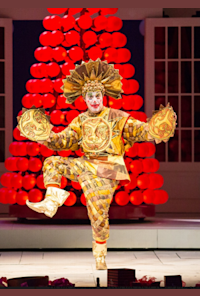Director Alla Sigalova and artist Pavel Kaplevich proposed a bold idea: to make an opera out of the legendary ballet "The Nutcracker"!
The production was timed to coincide with the 175th anniversary of the birth of Pyotr Tchaikovsky, one of the main musical dates of 2015.
Alla Sigalova, director:
I studied at the Choreographic School named after A.Y. Vaganova. Naturally, since November, a series of performances of The Nutcracker began on the stage of the Mariinsky Theatre, in which we participated, and since September there have been rehearsals. If the performances begin in November, then rehearsals start on the first of September, when you come to class. And – non-stop until February! And so all nine years of training. A few months off – and again "The Nutcracker". Every note of this piece lives in your every cell! Therefore, the idea to turn the ballet score into the opera "The Nutcracker" literally lay on the surface. Everything is connected with this music – childhood, my native St. Petersburg, the smell of the backstage, the stage of the Mariinsky Theater, the expectation of New Year's miracles – and all this for me is magical, alluring ... I treat this production as a gift of fate. I am happy to work with Tchaikovsky's music, to cooperate with talented people, I am glad that I have returned to the Novaya Opera - a theater with which the most beautiful memories of meeting with Evgeny Vladimirovich Kolobov, with outstanding soloists, choir artists who created amazing images in La Traviata, which we staged together 16 years ago, are associated. I am grateful to everyone who worked on the play. To create the opera "The Nutcracker" is a great responsibility! In the new work we brought our warmth, our cordiality, our experience and memories of childhood.
Igor Kadomtsev, author of the musical edition:
Pyotr Ilyich Tchaikovsky's The Nutcracker is the best ballet score in the world. And this is a classic example of ballet drama: the action is concentrated in the first act, the second, in fact, is a concert in costumes. The creators of the play distributed the dramatic action between the two acts, so their boundaries changed and several numbers moved from the second to the first. In particular, the acquaintance of dolls with the Nutcracker occurs in the first act. And the Nutcracker's fight with the mice turns out to be only Masha's dream. In this regard, it was necessary to swap several rooms and make cosmetic cuts. I note that many choreographers brought their own nuances to the dramaturgy of The Nutcracker.
The main task facing me and the musical director of the performance, Dmitry Yurovsky, was to reveal the operatic potential of the composition.
On the one hand, we have preserved, where possible, Tchaikovsky's authentic motifs; on the other hand, they also took care of the convenience of the singers. Our approach is integral: a vocal part is added to Tchaikovsky's score, and it is also based on the composer's material (for example, taken from other layers of musical fabric). If possible, the author's orchestration is preserved, but in some cases it is facilitated (otherwise you will not hear the singers). The only thing I allowed myself to compose was an aria of the Mouse King against the background of the fight (again from the motives of Tchaikovsky).






